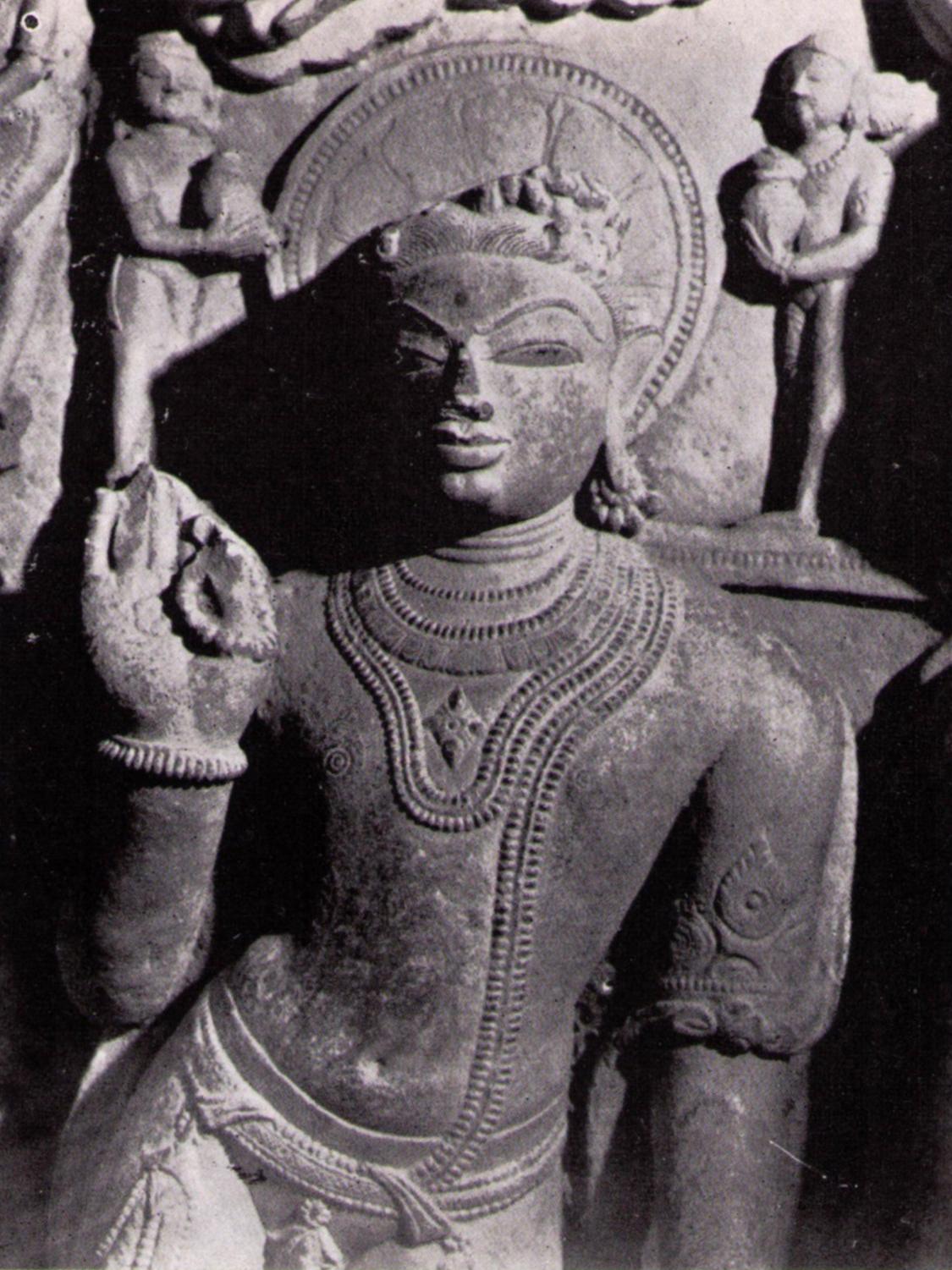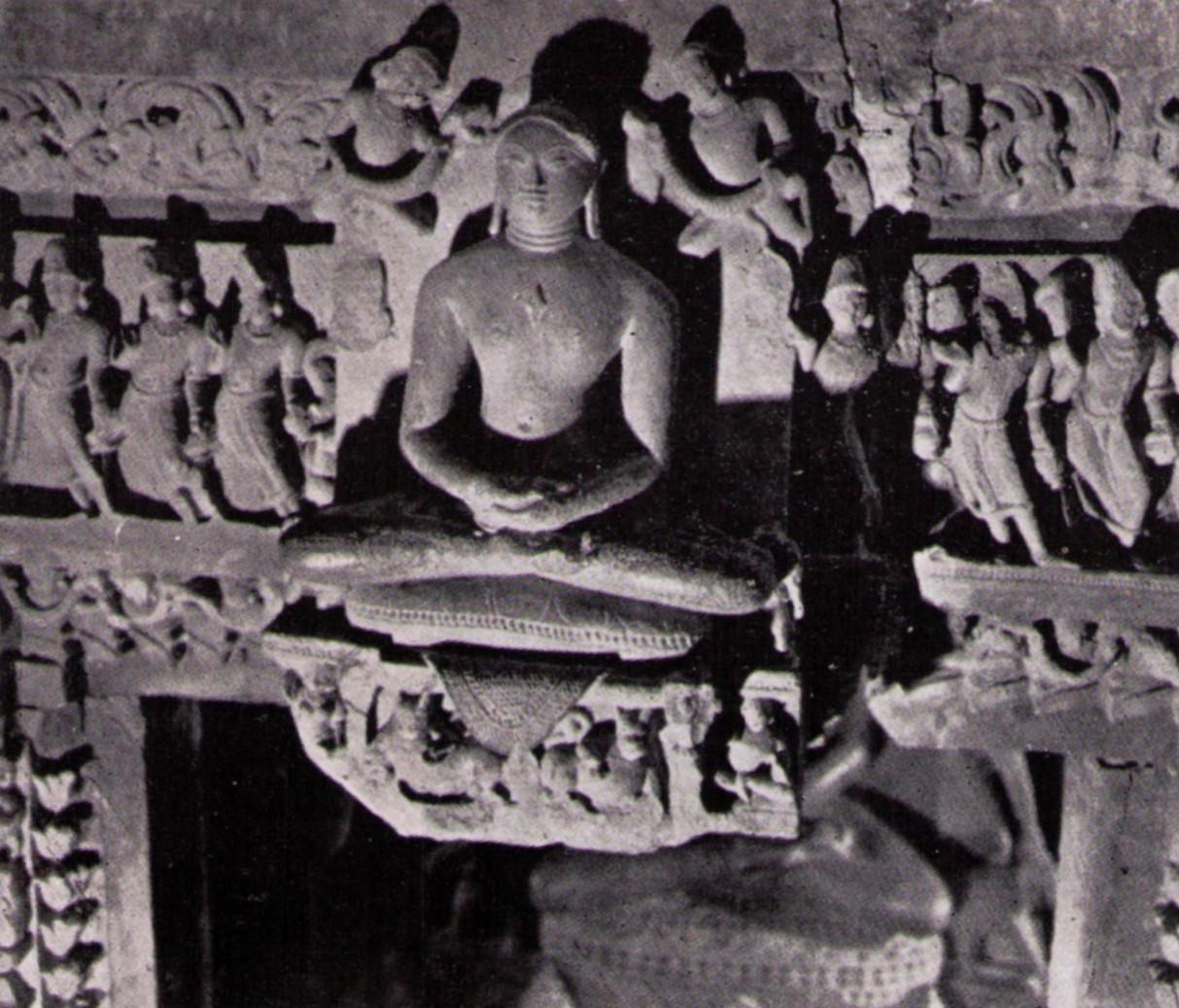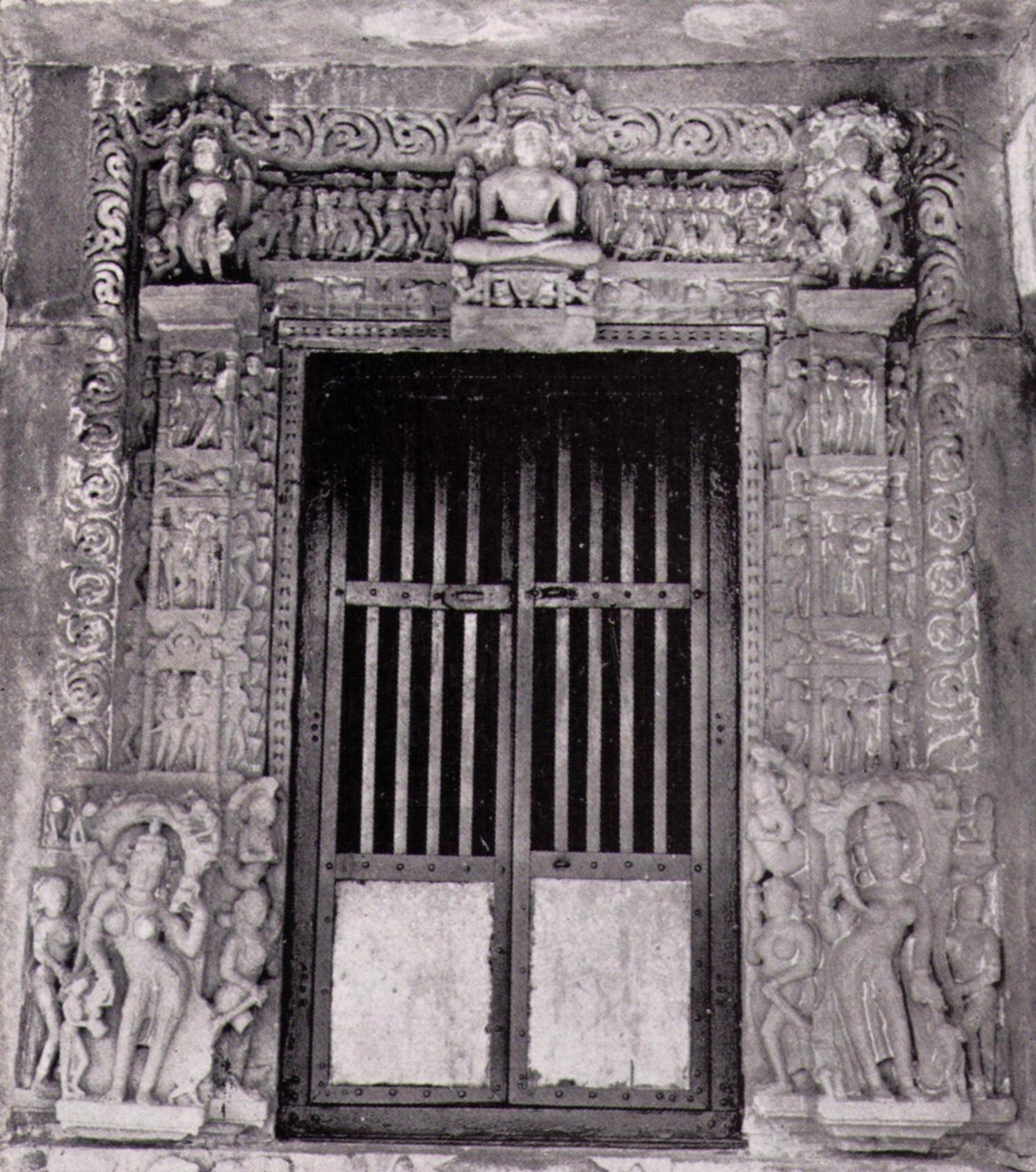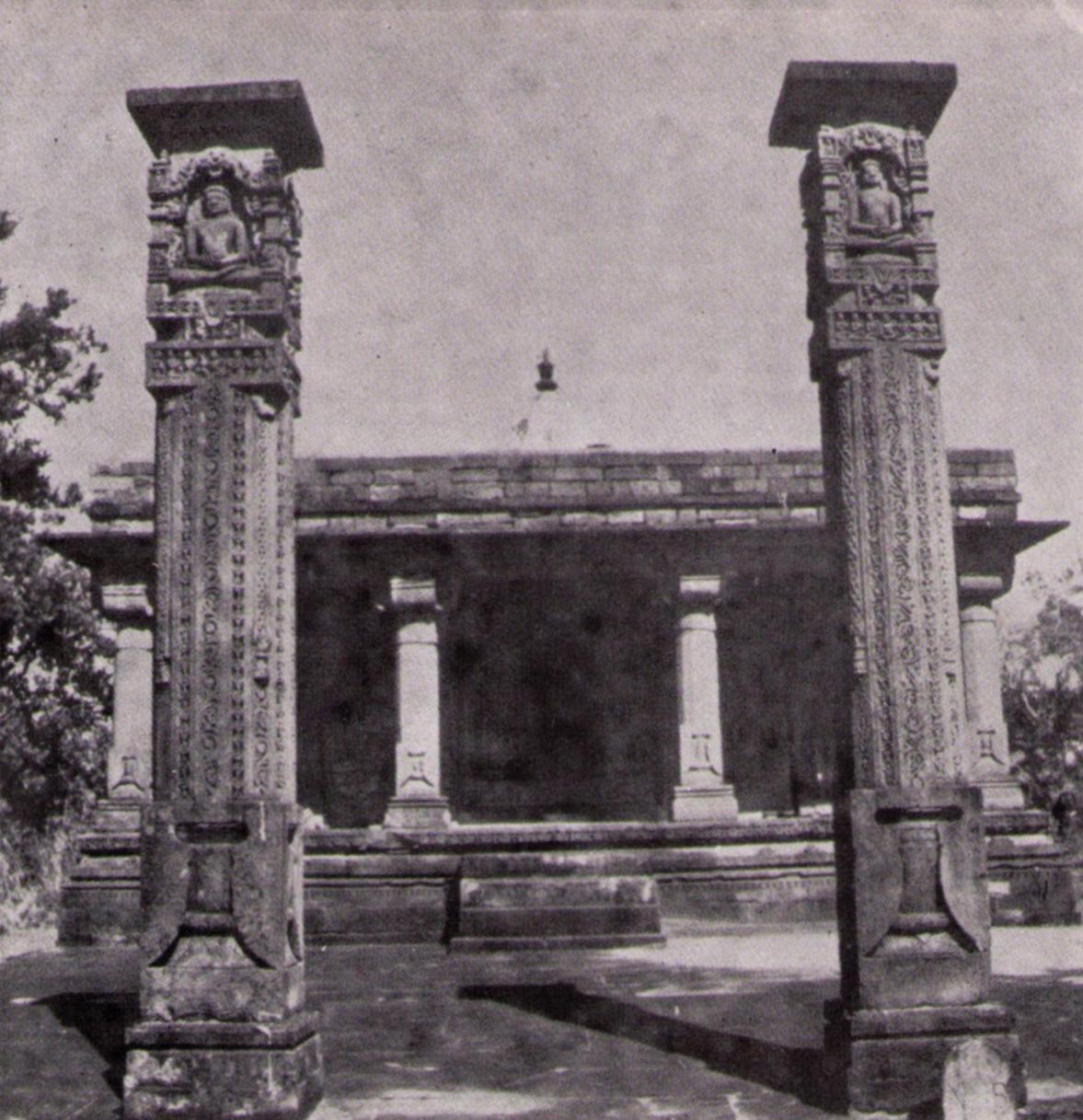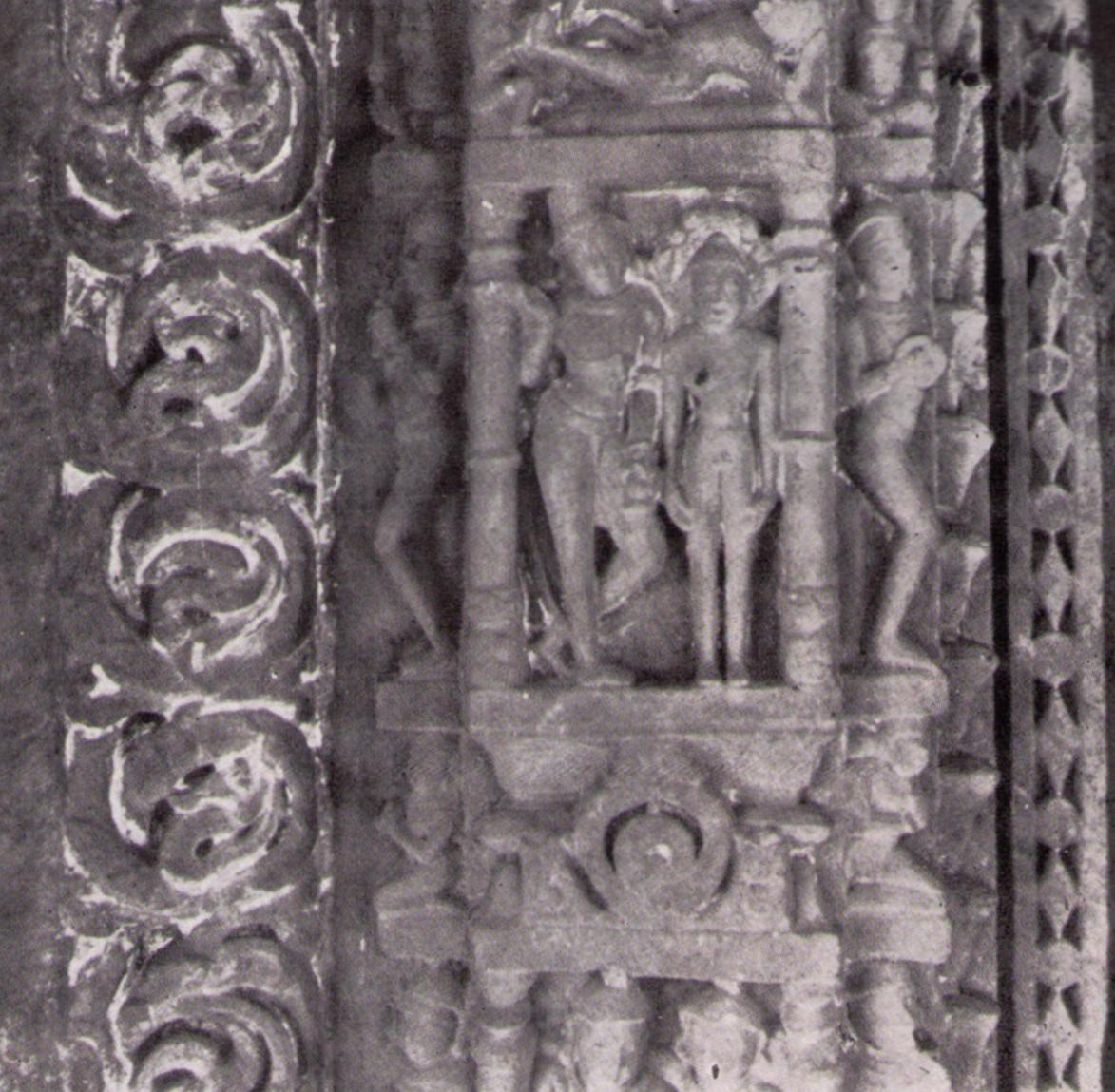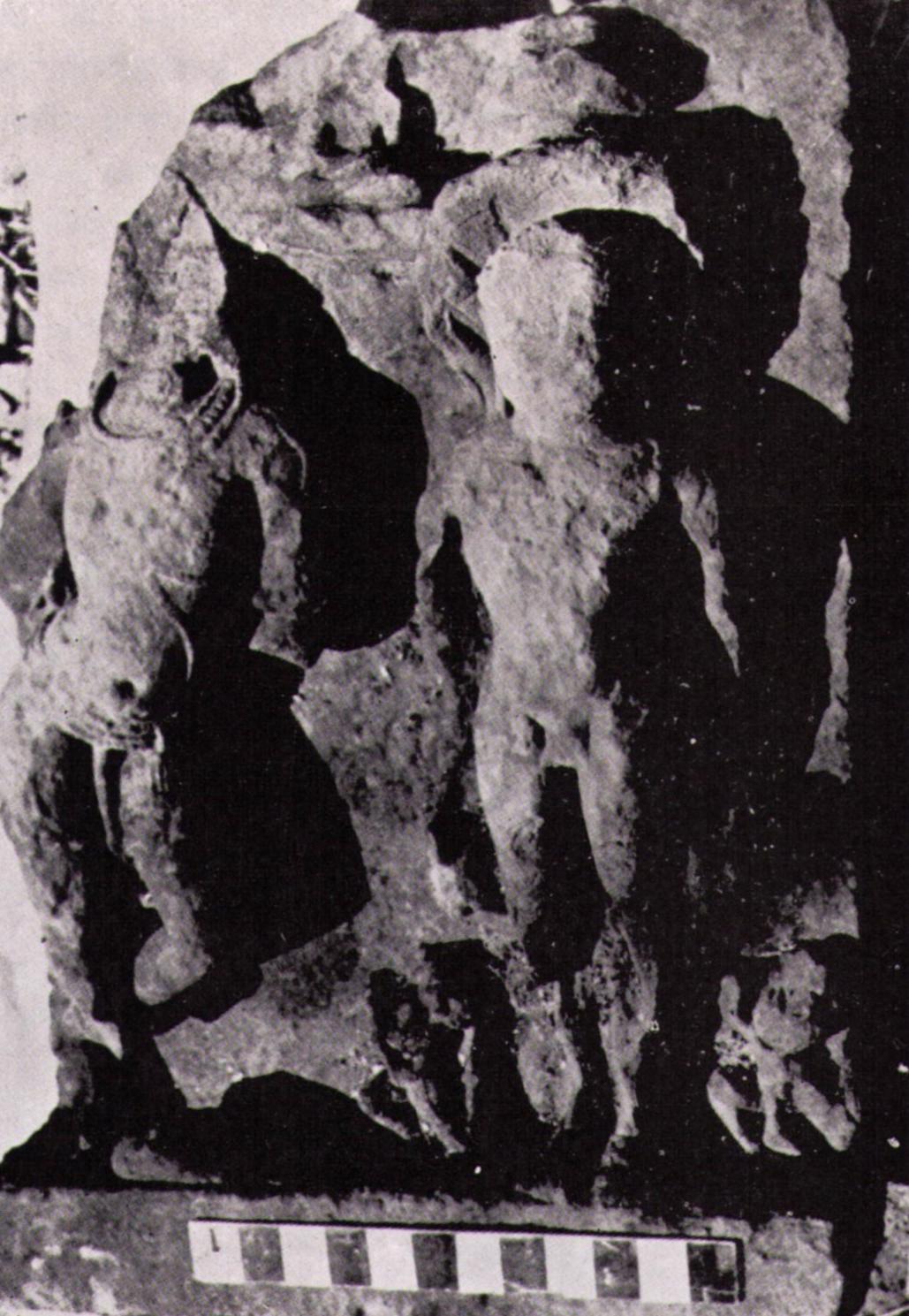
The following article by Prof. Klaus Bruhn was first published in the anthology Mahāvīra and His Teachings (ed. by A.N. Upadhye et al., Ahmedabad 1977, pp. 371-388).
Further Observations on the Iconography of Pārśvanātha
There is a wide-spread opinion - more often implied than explicitely expressed - that the iconography of Jainism is not very rich. Such a prejudice is nourished by the practice of including without much enthusiasm a few photos of Jina-images in books on Indian art and of leaving it at that. It is only recently that the discovery of the Jain a bronzes of Western India and their presentation to the world of scholars by Dr. Umakant P. Shah have to some extent changed the situation. We have to admit that Buddhist art as well as Hindu art have produced more motifs than the art of Jainism. However, this difference in respect of degree does not justify sweeping judgements. It would of course not be quite correct to say that Jaina iconography is rich simply because in addition to the Jinas many Jaina deities are represented. No doubt this is an important element in Jaina iconography. But one should not overlook the fact that the Jina iconography (iconography of the Tīrthaṅkaras or Jinas as distinct from the iconography of Jaina deities) shows in itself much more variety than is generally assumed. [1] Unfortunately such a statement cannot be substantiated in a short article. Nevertheless, the reader will feel that in the present inquiry two themes are interwoven, one more general (variety in the iconography of the Jina Pārśvanātha), one more specialized (a peculiar type of Pārśvanātha-image). - Before setting forth the argument I would like to thank Dr. Gritli von Mitterwallner (Munich University) for a few valuable suggestions.
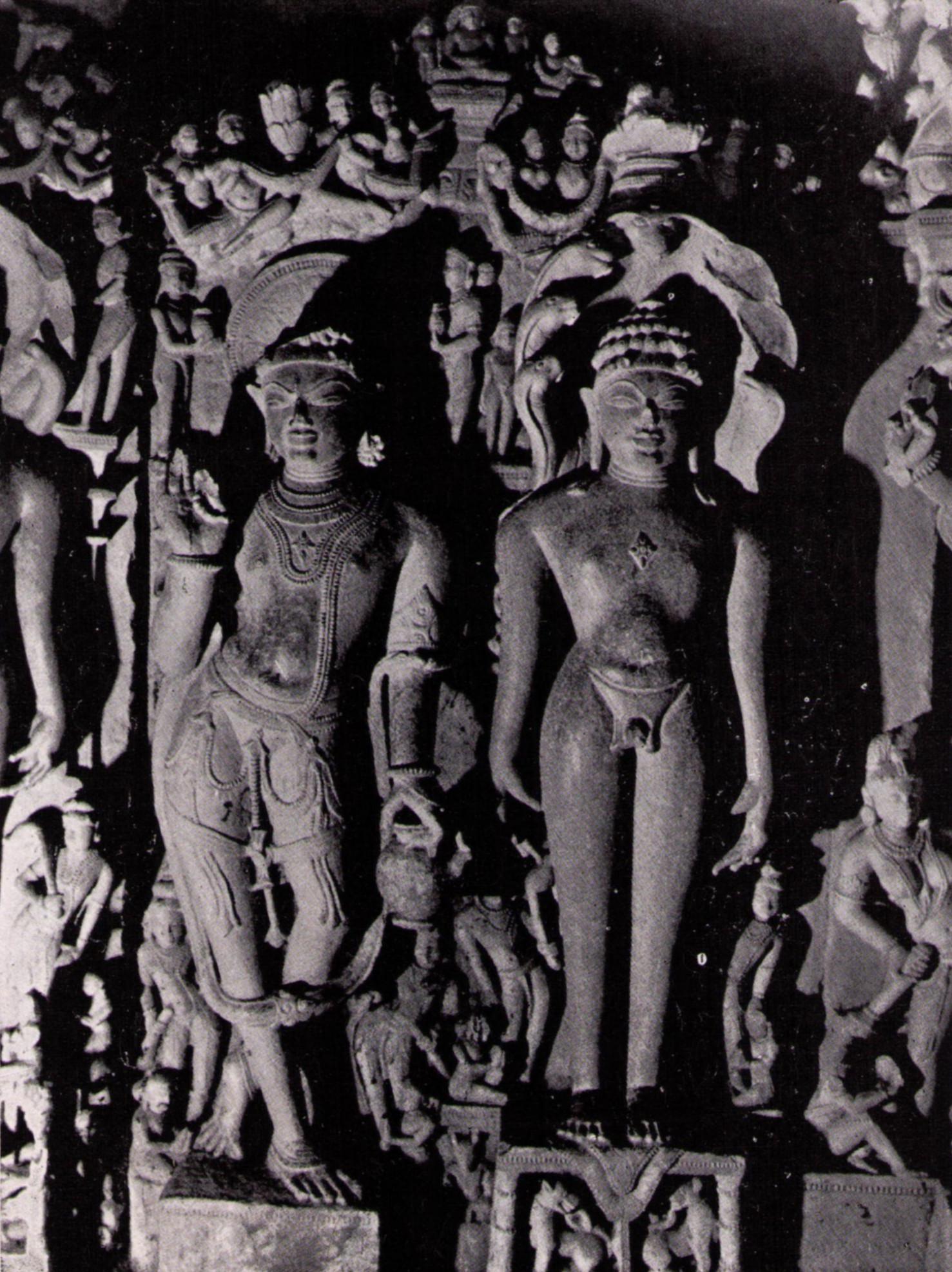
Fig. 1
I. "Main Divisions"
In § 233 of the Deogarh monograph (footnote 1, p. 371) it was pointed out that quite a few Pārśava-images do not follow the iconographic conventions. Several photos of such images were included in the book. In what follows I shall return to the same discussion.
Every student of Indian art knows that Pārśvanātha is represented with a "serpent-demon" or nāga behind his back. The nāga is Dharaṇendra, well-known from the legend of Pārśvanātha as narrated in Hemacandra's Triṣaṣṭiśalākāpuruṣacaritra, in Guṇabhadra's Uttarapurāṇa, and in other works of Jaina literature. The presence of the Dharaṇendra motif "attracted" other nāga motifs, and apart from this, the way in which Dharaṇendra was represented varied a good deal. Furthermore, it would appear that the iconography of Pārśvanātha deviates also in other respects from the iconography of the other twenty-three Jinas. For such deviations we shall use the term "peculiarities" (divisions i-iv below). Besides there are "irregularities". This term is employed if an individual Pārśva-image ignores either the canon of Pārśva iconography (division v) or the canon which is valid for all the Jinas (division vi). An exact definition of the terms used and a full explication of the scheme is not attempted.
It is necessary to add a few words on the difference between division (iii) and division (iv). The "Ṛṣi" to be discussed in the following Section clearly belongs to (iv), whereas the single jar or kalaśa appearing in rare cases below Pārśva is a nāga motif and must be classified as (iii) [2]. The female parasol-bearer with a snake-hood (Deogarh § 78), on the other hand, cannot easily be classified. The figure represents Dharaṇendra's wife as mentioned in the Pārśva legend. Female parasol-bearers with and without snake-hoods are, however, very common in Indian iconography, and in relation to this context it would be difficult to spot the exact source. Thus we arrive at the typical situation of rivalling explanations: a matter-of-fact explanation on the basis of literature and a zigzag line of associations on the basis of art (also compare Deogarh § 262).
Fig. 2
For practical reasons it was necessary in the above discussion to ignore the little-known iconography of Supārśva (the seventh Jina) who is likewise represented with a hood-circle. It is said that Pārśva (the twenty-third Jina) is shown with seven hoods, whereas Supārśva has only five. This is confirmed for example by a few images at Deogarh showing side by side one Jina with seven and one Jina with five snake-hoods. "Seven" is the normal number for Pārśva, and there cannot be any doubt that, in these cases, the other Jina is Supārśva. However, we would overload the discussion of Pārśva's iconography by regularly taking the iconography of Supārśva into consideration.
The title of the present Section is "main divisions". In other words, the six divisions (i-vi) are not just an effort to prepare a table of contents for an essay on the iconography of Pārśvanātha, but are intended to demonstrate a specific category. The total number of Pārśva-images must be considerable. We may content ourselves with an identification and stylistic classification of all these images. But this would not give an adequate idea of the extent of variation: quite different images may all show one and the same Jina (e.g. Pārśva) or one and the same god. Even Pārśva-images following more or less the same style may vary considerably in their iconography. All this is lost sight of if we look only for identity-and-style. Likewise we cannot organize this material on the basis of types. In the Deogarh monograph, much importance was attached to this category, and it is certainly indispensible in many contexts. However, it neglects the meaning and therefore separates Pārśva-images of different form from one another, while connecting the standard form of the seated Pārśva with images showing the seated Buddha sheltered by the nāga Mucilinda. The common sense category "main division", on the other hand, keeps all Pārśva-images together, and yet helps us to arrange this material and to obtain an overall view. It is natural that, in itself, a new category calls for some definition and clarification, but this cannot be achieved in the context of the present investigation. It cannot even be demonstrated that the emphasis on "main divisions" is more than a commonplace. The reader is, however, referred to p. 372 below where we use the term "main divisions" again (in connection with the Navagrahas). The distinction between "Pārśvas" and "non-Pārśvas" (frequently employed in the Deogarh monograph) is also a case in point. The assumed "competition" between different categories ("identification", "style", "type", "main division") may appear rather theoretical to the reader. However, categorization is not a monopoly of philosophers and grammarians, some such efforts being also necessary in the study of iconography.
II. Three Untypical Images of Pārśvanātha
The peculiarity to be discussed with respect to these images consists in the presentation to the proper left of Pārśvanātha of a figure which we shall designate as "Ṛṣi" (seer). This has been traced on two images (Figs. 1 and 7) and on a small doorframe panel (Fig. 6, for brevity's sake we use the term "image" in this case as well). The "Ṛṣi" has the hand-attributes.
Abhayamudrā (+/- akṣamālā) / kamaṇḍalu
protection-affording hand-pose (+/- rosary) / jar.Further characteristics: The Ṛṣi is as tall as (and "isocephalous" with) Pārśva. The composition is asymmetrical in so far as there is no figure corresponding to the Ṛṣi on the other side. The Ṛṣi appears on Pārśva's proper right. His legs are crossed.
Fig. 3
The first image (Figs. 1-2) is housed in a temple near Golakot (details on Golakot in Section VII). As the general characteristics of the Ṛṣi have been enumerated already and will be subjected to further scrutiny in the following Section III, we shall mention in the present context only features of the image which are not included in the above list. In treating the image, we shall distinguish between the Ṛṣi-composition and the Pārśva-composition.
The two remaining images (Figs. 6 and 7) belong to Deogarh. The context of the panel in Fig. 6 is clear from Fig. 4 showing the entire outer door-frame. The intermediate Fig. 5 shows the temple (Deogarh Temple No. 18) with two pillars - mānastambhas - in front of it. Some information on the temple was given in the Deogarh monograph (pp. 40-41, pp. 43 foll., P. C. Mukherji's plan in Fig. 1). Very little can be said about the small panel, except that it answers to the basic list of characteristics given above. The akṣamālā is missing, but this may be due to the small size which sometimes involves iconographic simplification. (Probably the strands of medieval miniature-Jinas have also to be explained by technical factors, the incision of parallel lines being easier than the rendering of minute curls; Deogarh § 298 A). The head of the Ṛṣi is crowned with a mukuṭa.
Fig. 4
During the time of my visits, the image of Fig. 7 lay amongst numerous debris near the eastern gateway of the rampart. The piece is badly mutilated and both hand-attributes of the Ṛṣi have disappeared. The crossed legs and the character of the entire image nevertheless leave no doubt as to the connection of the figure with the Ṛṣis of Figs. 1 and 6. Note the miniature-Jina at the top of the image, a motif which is reminiscent of the tritīrthikā on the Golakot image. The hovering figures, serving as it were as attendant figures of Pārśva, are unusual. The image belongs to the medieval period, but it is not possible to narrow down its date.
III. Parallels?
As observed already, the term "Ṛṣi" is not very appropriate in the case of our figure. But it is justifiable in so far as the "Ṛṣi" belongs to the wide range of figures commonly identified as "ṛsi" and well-known inter alia from early Varāha-images. The Planets or Grahas (here used in the sense of all Grahas except the pseudo-Planets Rāhu and Ketu) also show a close affinity to the ṛsi-type, and by coincidence the Grahas Śani (Saturn) as shown on many door-lintels in Madhya Deśa looks almost exactly like our Ṛṣi. Generally speaking, the Grahas appear either seated or standing. In the latter case we get the following "main divisions" when considering their postures:
- All Grahas have straight legs.
- All Grahas except Budha (Mercury) and Śani have straight legs.
- All Grahas except Śani have straight legs.
An additional difference, due to the fact that Sūrya (Sun) was exempted from the stylistic trend towards the tribhaṅga posture, can be neglected. In the case of division (iii) we get two subdivisions: either Śani's lameness (he is the slowest of all the planets known in antiquity) is represented in a fairly realistic manner (formula A) or his lameness is indicated by crossed legs which serve as an "ideogram" (formula B). Whatever the hair-dress or head-dress of the Grahas, their hand-attributes often follow the description of our Ṛṣi: abhaya (akṣamālā rendered but rarely in a clear manner) /kamaṇḍalu. Now the formula B is quite common in the medieval art of Madhya Deśa. Also the Grahas (ignoring Sūrya) are hardly distinguished from one another in these cases, each one showing as a rule abhaya/kamaṇḍalu. Hence the similarity between the Ṛṣi and contemporary renderings of Śani. The reader will find a detailed study of the Navagrahas in an article by Debala Mitra [3] which was also utilized by us for the above survey.
Numerous types have been derived from the original ṛsi-type; again we observe crossed legs with types of entirely different character, although such legs seem to be particularly common in the case of attendant figures. However, both "families" (ṛsi-types, types with crossed legs) do not show much overlapping, and it was under the circumstances not possible to find true relatives of our Ṛṣi. Leaving aside Śani, the closest parallel found was an image lying amongst the debris of Budhi Chanderi (Fig. 8, piece to the left; for the location of the site refer to Deogarh Fig. 390). Here a seated Śaiva ascetic is shown together with an attendant figure appearing on his proper left. However, the legs are not crossed in the true sense, and the hands are badly damaged. Probably the raised right hand of the attendant figure carried a fly-whisk or cāmara. On the other hand, the general arrangement of the two figures is strongly reminiscent of our three images with Pārśva and the Ṛṣi.
IV. "Heraldic" Figures
In Indian art, the main figure of an image is very often surrounded by other figures of smaller size, which shall be designated as "subsidiary figures" even though they may have the same rank as the central figure (from the point of view of their meaning). In most cases, some of these figures have names and can be identified. The others remain anonymous. If these anonymous figures are not purely decorative in character they may be interpreted by reference to an apparent or assumed function. The two following sentences demonstrate the character of modern interpretations: "Indeed, the emotion with which the god and his goddess are gazing at each other affects all the figures, both human and divine, privileged to behold the spectacle. Not only the donors and chowry bearers, but the hovering swarm of Śiva's hosts, the heavenly musicians, are filled with exalted bliss." For the ancient iconographic texts the problems of comprehensive and rational descriptions and interpretations hardly existed. The authors concentrated on figures with a name, and even these were mainly described, references to their connection with the main figure being not the rule. The standard phrase used is "kuryāt" or "kārayet" which simply indicates that the artist is expected to represent such and such a figure.
Fig. 5
Number and character of the subsidiary figures depend partly on the style of the image, partly on the iconographic section. Thus the iconographic programme of Viṣṇu-images is mostly-different in character from the programme of Śiva-images. The iconography of the Jina-images is characterised inter-alia by the presence of a smaller or greater number of miniature-Jinas surrounding the main Jina. Many of the remaining figures appearing on the images can be explained by reference to ancient descriptions of the preaching Jina as supplied by numerous works (Vyantarāḥ … pañcavarṇāni puṣpāṇi sugandhīny akiraṃś ca te: the gods showered flowers on the earth). However, the figures covered by such descriptions are not necessarily a peculiarity of the Jina iconography. Instead of entering into a long discussion of the subsidiary figures in Jina iconography we shall try to classify them. It may be added that this classification in a way supplements (on a more abstract level) the exposition of the category "main divisions". These are the classes:
- Functional or purely decorative figures (if not restricted to the iconography of the Jinas): throne-frame animals, hovering genii, etc.
Class (iv) calls for a comment. The concept of "heraldic" figures was developed with regard to our Ṛṣi although this is by no means a very important instance. Also, the Ṛṣi is not a subsidiary figure in the sense in which we employ this term. But in order to explain the term "heraldic" it was practical to submit a classification of the subsidiary figures as found in Jina iconography. It is easier to explain the meaning of the term "heraldic" in such a specific context than to isolate the relevant figures from the general pantheon of Indian iconography.
Heraldic figures have an identity (i.e. a name) or not; they may be closely associated with a particular figure (e.g. Pārśva) or not. What distinguished them is the fact that they belong to an intermediate zone between such figures as show a clear theological connection with the main figure (e.g. Yakṣa-and-Yakṣī in the case of the Jina) and figures which have no theological character at all (e.g. cāmara-bearers). This is a definition with regard to subsidiary figures, and here die Navagrahas appearing on many images (Jina-images and others) are one of the best examples. A general definition is difficult and we shall therefore content ourselves with an enumeration of typical cases in Indian iconography. Apart from the Navagrahas we can mention the following: Gaṇeśa, Lakṣmī, Sarasvatī, Garuḍa (i.e. Garuḍa without Viṣṇu), Gaṅgā, Yamunā, several nāga motifs (including the worshipping nāga transferred from the Kāliyadamana motif to various avatāra motifs: Gajendramokṣa, Nṛsiṃha, Trivikrama, Varāha). Some motifs are almost invariably "heraldic", others only in certain contexts. - The term "heraldic" has been chosen without much consideration for its current meaning. This is in no way intended to exclude the employment of an alternative term.
V. Syntax
The present article offers an opportunity to re-examine some of the theoretical sections of the Deogarh monograph, and as the matter in question shows some analogy to syntactical problems in language we have chosen the above heading.
In the first instance, the present inquiry offers an opportunity to supplement Deogarh § 233 (unconventional Pārśva-images) by a more systematic discussion of the issue. Again, a few elements of our article simply confirm observations made in the Deogarh monograph. Compare Section II (point x) with Deogarh § 293: rigidity of iconographic conventions. The Ṛṣi is a contribute of Pārśva in the sense of Deogarh § 297. The description of the Golakot image in Section II is a demonstration for Deogarh § 321: necessity of distribution data in the description of isolated images.
Fig. 6
The main difference between the Deogarh monograph and the present article is that the latter gives greater emphasis to meaning (as opposed to mere form). This takes shape mainly through the introduction of the category of "main divisions" - acting as a rival of the category type. See Deogarh § 277 (figure-type) and § 280 (motif-type; refer also to §§ 281-82). Again, the classification in Section IV acts as a rival of the category system in certain connections (Deogarh §§ 320 and 262). Finally, the greater consideration given to meaning affects the problem of documentation. In the Deogarh monograph, normal "inventories" were proposed for monuments in general (§§ 6 and 324). However, "type" was always used in a strictly formal sense. Therefore the chapter on Methods for Practice did include some remarks on the scope for surveys in the field of the category type, (§ 318), but the common sense terms "Jina type" or "Pārśva type" had no place in the methodological system of the book. Thus the most practical and simplest approach to iconographical documentation was not even mentioned. The Section that follows will perhaps compensate this omission to some extent.
VI. Documentation
In Archaeology, documentation has more than one possible form: lists of sites, lists of monuments, museum catalogues, lists of photographs. Such inventories may or may not include photographic material. Photographs are found in public and private collections. As far as early Indian art is concerned, most of the important objects have been "published" (i.e. illustrated by good photographs). After the Kuṣāṇa and Gupta periods the percentage of published objects diminishes. Amongst the most neglected materials are the numerous images and architectural pieces scattered all over Madhya Deśa and belonging to the "post-Gupta", "early-medieval" or "medieval" periods. Below we give a list of published and unpublished photographs relevant to the iconography of Pārśvanātha, the theme here under discussion. The list may cover nine tenths of the published and a fraction of the unpublished photographs. The reader will be able to judge for himself how many Pārśva-images have not even been photographed (Section VII below). Photographs of sculptured cubes or caumukhas having Pārśva on one of their four sides are not considered if they show one of the other sides. What is understood by "Madhya Deśa" will be seen from the place-names quoted.
- Published photographs
- Unpublished photographs.
VII. Forgotten Images
The image shown in Figs. 1-2 was noticed in a structure near Golakot, two miles south-west of Gudar (Deogarh Fig. 390). Both Golakot and Gudar (Goodar) are situated in the Picchora Tahsil (Shivpuri District, Gwalior Division, Madhya Pradesh). See the District Census Handbook (1961) for the Shivpuri District (map etc.).
Fig. 7
Apart from the outer and inner door-frames, the building has no architectural embellishment. It rises on a squarish plan and has two rooms, an oblong "garbhagṛha" in the rear (reached by the inner doorway) and a larger room in front (reached by the outer doorway). For this type of structure compare Temple No. 3 at Deogarh (eastern section and western section before the erection of the present temple; Deogarh Fig. 1). The central part of the inner lintel is reproduced in Fig. 3. It shows a Jina on the dedicatory block, while the Navagrahas appear to the left and to the right on the lintel proper. The garbhagṛha houses 19 images, and 17 are kept in the room in front. The style of the images corresponds more or less to that of the Hovering Class (Deogarh Chapter 12 and § 256). A few images reflect later stylistic developments, and this is particularly true of the image of the sacred couple (parents of the Jina) standing in the front room. Two images show non-Jinas (sacred couple standing, Cakreśvarī seated), our image shows a Jina and a non-Jina, and the remaining pieces show seated (9) or standing (24) Jinas. As usual, the seated images are more elaborate than the standing ones. Especially noteworthy is the seated Jina-image in the middle of the garbhagṛha (in Fig. 3 dimly visible below the dedicatory block). The protruding knees (i.e. knees protruding beyond the cushion) are a common feature of this image and of the Jina on the dedicatory block. None of the images shows an inscription, and this is also true of the structure itself. - Remains of another Jaina temple were noticed nearby. This was not a plain building but followed the architectural design of the period, having projections etc. No images were found, but the richly carved lintel showed Jinas (J) alternating with goddesses (G):
J-[G]-J-[G]-J-[G]-J-[G]-J-[G]-J.
It would be tempting to write a separate article on the Jaina remains at Golakot. However, my photographic material is far from complete. The present location of the images is also not known to me, but they certainly suffered during the notorious activities of art-robbers in 1959, so that a complete survey is no longer possible. Moreover, some of the best pieces have been published by now: a seated Ṛṣabha (Deogarh Figs. 213, 213A, 213B), the seated Cakreśvarī (Deogarh Fig. 227), the Jina-Ṛṣi-image, the central part of the inner door-frame. Thus Golakot was, is, and will remain a forgotten site, only known to or remembered by the members of the Jaina communities in the nearby settlements of Khaniadhana, Gudar and Pachrai. Archaeological reports supply but scanty information on the place.
Readers of the Deogarh monograph will remember that the necessity of adequate preservation measurements and of adequate surveys was underlined on more than one occasion. We mentioned above that the "documentation" in Section VI was far from complete. Here we can only add a few general remarks. Scattered Jaina images (mainly Jina-images) are found all over Madhya Deśa. They could be brought to safer places. However, such modern migrations of mūrtis already involve a certain loss: the piece is separated from its original local context. Clusters of mūrtis which belong together may be separated, while pieces of different provenance are placed side by side in the museums. It would be possible to keep records of the find-spots, but only very accurate notes could permit a full reconstruction of the artistic heritage of a particular site. Small museums on the spot and adequate measures to safeguard the temples and their mūrtis are more satisfactory from the point of view of the art-historian, but the technical difficulties are obvious. Thus the type of measurement to be taken in each case depends on the specific situation. Complete photographic surveys of movable sculptures are carried out in some European countries to discourage art-thieves; a known piece is sold with difficulty. But the problems involved in comprehensive photographic surveys are too clear to require specification.
Fig. 8
To illustrate the situation we shall add a few descriptions from reports. No doubt the records are old, and the present situation at the sites mentioned could not be checked. It is, however, unlikely that the general condition has changed considerably during the past decades. The names of the villages are - for obvious reasons - fictitious.
Klaus Bruhn, The Jina-images of Deogarh, E.J. Brill Leiden (1969), pp. 3-4. Below, this book will be referred to as Deogarh monograph or (in the case of quotations) as Deogarh.
Compare U. P. Shah, Studies in Jaina Art, Banaras 1955, Fig. 38 (image from Bankura) with the relevant examples from the iconography of the Hindu goddess Manasā. E.g. R.D. Banerji, Eastern Indian School of Mediaeval Sculpture, Delhi 1933, Pl. 64 b-d.
 Prof. Dr. Klaus Bruhn
Prof. Dr. Klaus Bruhn
